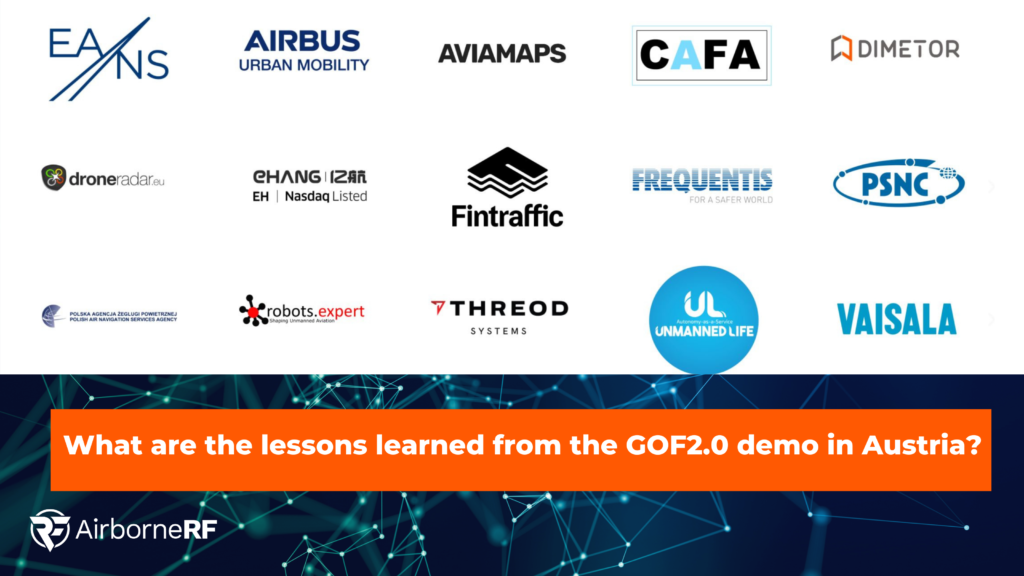GOF2.0 project was created to show the operational validity of combining Air Traffic Management, U-space services and systems by creating shared interoperable infrastructure for manned and unmanned aviation.
During the trial on the 5th of October in Austria a first live end-to-end telecom-aviation data integration was demonstrated together with the Austrian mobile network operator Drei. Dimetor’s solution AirborneRF provided critical connectivity and ground risk information for the flight of BVLOS drones.
The System-of-Systems used real-time information exchange – such as flight plans, telemetry, alerts, GeoZones, and cellular connectivity coverage – between Drone operators and Unmanned Traffic Management (UTM) systems.
Here are our six takeaways from the trial
- Connectivity Data is a New Layer in UTM
The first and crucial takeaway from the project focuses on connectivity data and its’ role as a new layer in the UTM. Project stakeholders demonstrated that fully automated, seamless interaction between Mobile Network Operators (MNO) and aviation operators is possible and mandatory because it reduces risk. Risk reduction is a top priority while establishing communication and connectivity.
It is now clear that the Network Coverage Service, defined by the Aerial Connectivity Joint Activity initiative, and used as the basis for the data exchange, works. ACJA is a joint initiative of GSMA and GUTMA. GSMA is a global organization unifying the mobile ecosystem to foster innovation to support business environments and societal changes. GUTMA is a global association that aims at fostering the safe, secure and efficient integration of drones in the airspace.
- Aviation Community is Excited About Possibilities
The second takeaway points out that the aviation community is excited about connectivity integration’s current and future possibilities. The Air Navigation Service Providers (ANSP), responsible for separation among airspace users, are particularly adamant that communication is a must for safety and security. Partners of the GOF 2.0 project agree that the Air Traffic Control (ATC) will also need to know where telemetry and other safety-critical information can be provided or is at risk, and where no communication with the UAV is expected.
- Mobile Network Operators are Able and Willing to Provide the Data
The third takeaway demonstrates that mobile network operators can provide the required information in near-real-time. Partners agreed that they couldn’t violate privacy, and that they need to protect data while processing it according to legislation and guidelines of data protection authorities. However, the project is proud to report that both data confidentiality and security issues have been solved.
- Service Level Agreements (SLA) will require pre- and in-flight information
The fourth takeaway is that SLAs must require both preflight and in-flight information. Connectivity information is needed for the pre-flight situational awareness (planning/clearing) but this is not enough. SLAs also require the exchange of in-flight information, in case that anything happens to the communication link performance. Monitoring and measurements of critical parameters are essential to enable SLA compliance. We must monitor in real-time the quality of the communication.
- Need of Redundancy
The fifth takeaway indicates the necessity of redundancy in communications. How can we minimize the areas where communication quality is poor or where there is no communication coverage? What systems can eliminate such regions? It is becoming evident that redundant and dissimilar means of communication will have to be established. Several options will be available with cellular, propriety and Satcom connectivity emerging as clear winners for drone operators.
- High Interest in Ground Risk Information
The sixth takeaway from the project confirmed the drone operators’ high-interest in-ground risk information, which is one of the two pillars of specific operations risk assessment methodology, SORA. Automated risk assessment requires data about where people are. MNOs will play a more significant role than expected before. Once data interfaces and sharing agreements are in place, MNO will be able to provide the location of mobiles and, consequently, where people are in full compliance with privacy and telecom regulations. This will mark a significant improvement in the approach to SORA approvals and the path to automated BVLOS operations at scale.
The demonstration highlighted that the evaluation of the quality of communication is a crucial element of the safety of U-Space as it improves the command and control of the drone and its localization. It also enhances the quality of data transmitted by the payload of the drone. By utilizing AirborneRF solution in the GOF2.0 project, the stakeholders received real time information on the availability of robust connectivity in the airspace. The system also delivered the essential information to drone operators and Air Traffic Management Systems early in the flight planning phases, making it possible to make intelligent decisions and replan the flight route if needed.
Feel free to contact us at AirborneRF for more information, and please do revisit our blog soon for the latest news.
Remember to follow us on LinkedIn and Twitter to be the first to hear AirborneRF’s news and updates.

